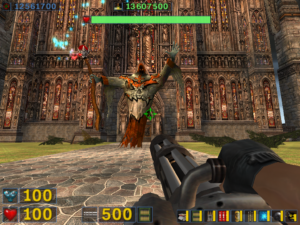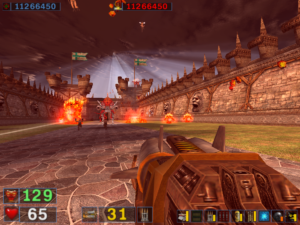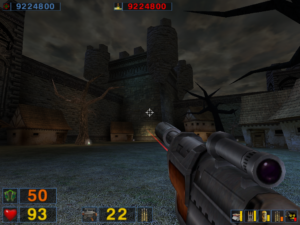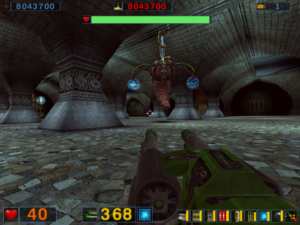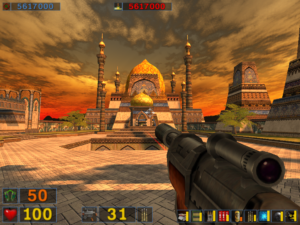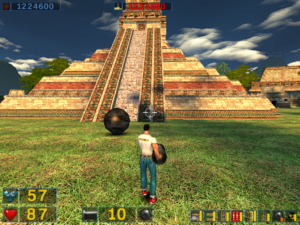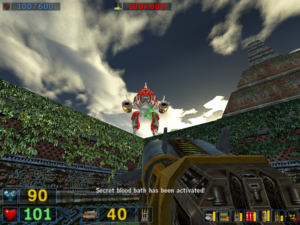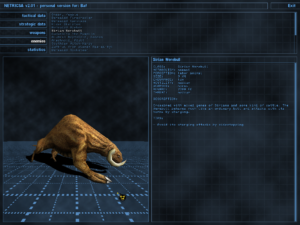Portal (the other one)
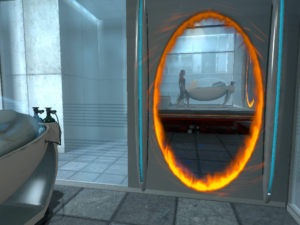 OK, enough smart-aleckry. I really did want to try Portal (Activision, 1986), and I could easily make another post or two about its content, but let’s talk about Portal (Valve, 2007). It’s a real gamer’s game, impossible to do in any other medium. I’m going to skip over the basics here, because they seem to have become an unavoidable part of geek culture just now. Something Awful and xkcd have riffed on the game, and “The cake is a lie” has become almost as oft-quoted a catchphrase as the intro to Zero Wing was a few years back.
OK, enough smart-aleckry. I really did want to try Portal (Activision, 1986), and I could easily make another post or two about its content, but let’s talk about Portal (Valve, 2007). It’s a real gamer’s game, impossible to do in any other medium. I’m going to skip over the basics here, because they seem to have become an unavoidable part of geek culture just now. Something Awful and xkcd have riffed on the game, and “The cake is a lie” has become almost as oft-quoted a catchphrase as the intro to Zero Wing was a few years back.
And there’s a big lesson right there. Six months ago, if you asked anyone who paid any attention to the game industry what the defining game of the year was going to be, there’s a good chance that they would have said Halo 3. It had the big marketing push, the tie-in products, the article in Wired about their innovative development process. Microsoft positioned it as the Xbox 360’s killer app, and tried to make its launch into as major an event as the release of the final Harry Potter book. And they sold a squillion copies, because obviously everyone with an Xbox 360 had to have it, if only because nothing else of note was being released for the Xbox 360. But once they bought it, it just seemed to sink out of sight. No one talked about it — what was there to talk about? No, the game that people are actually still talking about is one created as an extra for an anthology package. I suppose that the folks at Valve felt that this was a relatively safe place to experiment, as there was essentially no money riding on Portal‘s success. In that regard it resembles an indie title, but thanks to its tie to Half-Life, it got a lot of polish and a wide release. The best of both worlds.
One of the most obvious ways this affected the game is that the developers didn’t feel it necessary to pad it out to the length that people expect of a major release. There isn’t a lot of repetition in the puzzles, and when an element is repeated, it’s generally to expose a new twist on the idea. This is generally a good thing, but I did feel that the puzzle elements had some unexplored potential. For example, the game never really takes advantage of the portals’ ability to reorient the player, apart from turning vertical momentum into horizontal momentum. But maybe there are some fan-made levels by now that do this sort of thing. That seems to be what fan levels are for: exploiting every detail.
Since Portal‘s memes are in the air and hard to avoid, I knew a fair amount about what to expect going in, including some things, such as the fate of the Weighted Companion Cube, that it would probably have been better not to know in advance. But there were still surprises. I’m going to get a little spoilery, so if you haven’t played the game yet, for goodness sake do so now. If you don’t want to spring for the entire Orange Box, you can get Portal individually via Steam for $20. This may seem like a lot for a game that takes about four hours to finish, but it’s a very high-quality four hours, and no more expensive than going to a cinema and watching two two-hour movies. And the movies wouldn’t even have bonus levels afterward.
Somewhat perversely, I had played the fan-made 2D Flash version before playing the original game. As a result, I was somewhat taken aback by how much tutorial the original has (especially given its length), and the way that it doles out the portal-making capabilities piece by piece. The Flash version gets started a lot faster, and actually does better job, in some ways, of exploring the puzzle potential of the basic concept. But it has a very different nature: it’s just a straightforward series of puzzles, culminating in cake (no lie).
Whereas Portal itself subverts exactly this structure beautifully. You have a set sequence of 19 puzzle-based levels to complete, as you’re reminded by the helpful signs at the beginning of each test area, and the last of those 19 levels is exactly what we’ve come to expect of final levels in puzzle-based games: it’s a kind of a final exam of all the techniques you’ve learned over the course of the game. The thing is, the game is only about half over at that point. Afterward, the narrative goes off the rails. Just the narrative, mind you. The gameplay is just as linear and level-based as ever. But for me, at least, escaping into the guts of the complex provoked a stronger sense of panic than anything else in the game. At one point early in that section, I was convinced that GLaDOS had sent something to chase me, on the basis of a couple of triggered motions and some ambiguity about the source of the sound effects, and I hurried to get someplace that could only be reached by portals. I think I was wrong about that — nothing of the sort happened in the game before or afterward. But it was a plausible development: I had broken the rules, so GLaDOS could break them too.
GLaDOS really steals the show, by the way. She reminds me a lot of SHODAN from the System Shock games, but less gothic and more childish. Somehow, the way she keeps repeating lies that have already been exposed, apparently unable to comprehend that you might not trust her, manages to keep being delightful. And her closing song, “Still Alive”, has managed to replace “Invisible Musical Friend” (the Skullmonkeys bonus room theme) as best videogame song of all time. I honestly don’t know if the game would have been able to find its way into everyone’s hearts without her setting the tone. It would still have the gameplay and the puzzles, of course, and Valve managed a similar sort of sardonic deadpan humor without her in Half-Life, but it’s not really the same.
 Comments(2)
Comments(2)